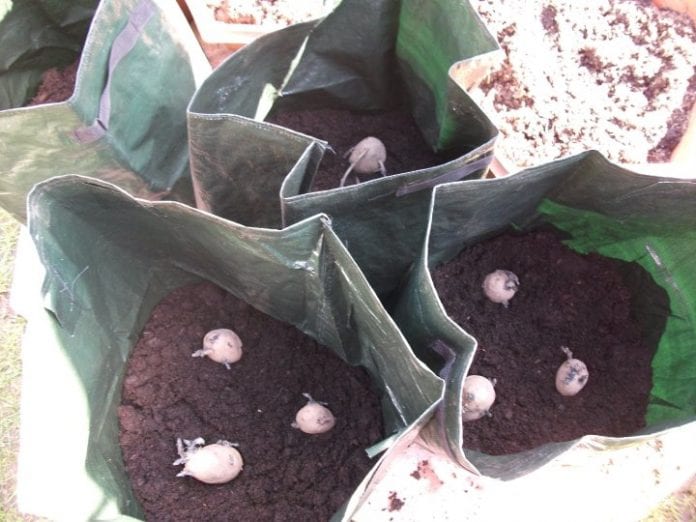In a society that is, for the most part, removed from everyday farming, it’s always intriguing to ask young children where potatoes come from. When I asked a group of Year 2 pupils, several thought they grew on trees, and some just answered ‘Tesco’!
Growing potatoes in sacks or pots is really easy, and a fun experiment to do with young children to show them different ways in which our food grows – nothing beats their excitement when they tip out a sack of soil and discover the treasures within!
Many of us live in houses with little in the way of garden to turn over to vegetable growing, or we may lack the physical ability to work heavy soils; so growing in containers is a simple, no-fuss, no –dig method of food production. In this piece, I’m going to talk about potato sacks, which are readily available in garden centres, homeware shops and online; because used sacks are easier to store than pots if you’re short on space; but you can use large pots if you prefer.
The first thing you are going to need are your seed potatoes. These are usually available from the beginning of the year in garden centres and seed catalogues; so your first big choice is what kind of potato you want to grow. Some of the terms on seed potato packaging might sound rather mysterious, but it’s very straightforward:
First Earlies – are your waxy NEW or SALAD potatoes and are generally ready 10 weeks after planting
Second Earlies – are, again, waxy new/salad potatoes and are generally ready 13 weeks after planting
Maincrop – these are your chippers, roasters and mashers and tend to be ready 20 weeks after planting.
When buying seed potatoes, look to ensure they are from certified stock to ensure they are disease free; and choose smooth, unblemished potatoes that aren’t wrinkled or shriveled.
Chitting
The next stage is to ‘chit’ your potatoes. It’s not absolutely necessary, but it gets your spuds off to a fast start when you plant them.
You know when you leave a bag of shop-bought spuds in the bottom of the kitchen cupboard of doom and they start to sprout white ‘roots’? That’s chitting. The best way to chit potatoes is to pop them into an open egg-box and store them for a few weeks in a cold, frost-free room out of direct sunlight until they start to grow their shoots.
When to plant
In West Wales, usually late March onwards is safe to plant, unless you live in a frost pocket. Potatoes really don’t like frost very much so it’s always best to wait rather than rush straight in. Horticultural fleece is very handy to have to cover your sacks if an unexpected cold-snap appears; but at least with this method of growing you won’t have leaf damage at this early stage as you would experience if you were growing in the ground.
How to plant
Open up your potato sacks and roll down the sides so each sack is approximately 1.5ft high. Put them in the spot you want to grow them in – potatoes do prefer full sun but can cope with semi-shade.
To the bottom of the sack, add around six inches of compost (I use organic peat free compost) and then place three chitted potatoes in each sack. Position them in such a way as that the majority of white sprouted shoots are pointed up. Cover them with another six inches of compost and water well. Remember to mark your planting date on your calendar.
Keep the soil damp, either water a little every day or give them a good drenching every four days or so; but stay consistent. After a few weeks you will see the haulm – that’s leaves to you and I – appearing through the soil. COVER THEM UP WITH MORE SOIL! I know, right? Trust me on this!
Every time you see the haulm showing, cover it with soil until you’ve unrolled the sack to the very top and can’t get any more soil in; and then just let nature do its thing. The plants will flower, and might even fruit (tiny fruits that look rather like tomatoes, but unedible – they are part of the same family) and at around the weeks given above, the haulm should start to yellow and collapse.
(Obviously you won’t be able to roll down the sides of a pot, so just keep filling up over those leaves until you get to the top.)
How to harvest
This is the magic moment, and the part that children absolutely love. The easiest way I find to do it is to spread out a groundsheet/tarp and simply tip the contents of the sack out onto it. This way you can just rummage through with your hands rather than risk damaging the tubers with a garden fork. Alternatively, you could sit back with a hard-earned glass of something cold, and get the kids to do it for you, which is my modus operandi. They have to learn sometime, right?
We have managed on average to get four or five meals worth of potatoes (based on a family of four) from each sack of earlies; slightly less on maincrop (but you get bigger potatoes). You may find you get a lot of annoyingly tiny ones – they make fantastic potato salad, so don’t throw them out.
The spent compost can be reinvigorated with fertilizer such as Fish, Blood and Bone and used again for flowers or salads; or left as is and used for herbs, most of which do not like an overly rich soil.
Blight
Occasionally, maincrop potatoes can become affected by blight. Earlies are generally harvested before the risk of blight is at its highest. You’ll know if you have it, as your crop will go brown and ‘wet-rot’ and go slimy incredibly quickly. If you do think you have blight, if you catch it early enough your tubers may be fine (the tubers themselves rot at the later stages of blight) and you can harvest the potatoes; but please do NOT add infected leaves or any infected potato tubers into your composting bin or council garden waste bin. Put it in your general household waste bin or, preferably, burn it. Do not leave it longer than necessary as the blight spores can be spread on the wind to neighbouring gardens.
I hope you’ve enjoyed this guide to easy potato growing – home grown tastes so different to anything you get in the shops, and it’s so easy to do. Anything else you fancy growing? Let me know!
Help keep news FREE for our readers
Supporting your local community newspaper/online news outlet is crucial now more than ever. If you believe in independent journalism, then consider making a valuable contribution by making a one-time or monthly donation. We operate in rural areas where providing unbiased news can be challenging. Read More About Supporting The West Wales Chronicle


























